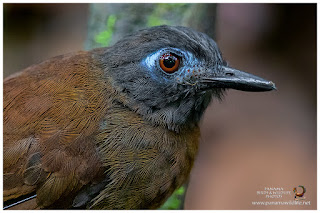This week we bring you the second part of this special report from Pipeline Road and its surroundings. As mentioned in the previous part, we found another swarm of ants (to us it seemed like a different, smaller type of ant, and a smaller swarm), at this place we observed some other birds showing the opportunistic habit of catching small animals that escaped the ants. Here we observed Song Wrens, Chestnut-backed Antbirds (a male/female pair) and White-whiskered Puffbirds, also a Spotted Antbird (female) came a couple of times.
These birds were in a feeding frenzy moving in circles inside the area of action of the ants, sometimes remaining still for seconds. They were coming and going, minding their own business and didn't care about our presence. Once we observed this attitude, we decided to stay there and wait for picture opportunities. It was not easy due to the darkness of the place and the excessive vegetation blocking clear views of the birds. As always, we made our best effort to bring you the following pictures.
Chestnut-backed Antbird - female
Chestnut-backed Antbirds - male
The Chestnut-backed Antbird (Myrmeciza exsul) is found in humid forests in Central and South America, ranging from eastern Nicaragua to western Ecuador. It mainly occurs in lowlands up to an altitude of 900 metres (3,000 ft), but locally it occurs higher. It occurs in lower leves of forest, understory thickets of wet forest, close to ground, especially at edges, along streams and in old treefall clearings, and in adjacent tall second growth. Both sexes have a pale blue bare patch of skin around each eye. The adult male has a blackish head, neck and breast, and the rest of the upperparts, wings and tail are chestnut. The flanks and the lower belly are a somewhat darker brown. The female has a brownish-black head and neck, but this does not extend to the breast.
The chestnut-backed antbird is normally found as pairs throughout the year, but occasionally joins mixed-species feeding flocks or army ants. It feeds on insects, other arthropods, and sometimes small frogs or lizards taken from leaf litter and vine tangles in low vegetation or on the ground.
It is easier to hear than see in its dense habitat, but can be attracted by imitating its whistled song. It may then give a territorial display with puffed-up body, drooped wings, and pumping tail. In Panama, it's common on entire Caribbean slope and parts of the Pacific.
The male Chestnut-backed Antbirds above where photographed in two different occasions. You might notice the males have different eye-color. One was in the ants' place along the female, while the other was found wandering alone. At Pipeline Road we also saw Song Wrens and Black-bellied Wrens, both were very hard to photograph.
Song Wren (Cyphorhinus phaeocephalus)
This Black-bellied Wren (Pheugopedius fasciatoventris), was not in the swarm but we had the opportunity to make a picture while he was passing by.
White-whiskered Puffbirds - female
White-whiskered Puffbirds - male
The White-whiskered Puffbird (Malacoptila panamensis) is found from southeastern Mexico to central Ecuador. This puffbird is found in forests, shady plantations, especially cacao ones, and old second growth in lowlands and foothills up to 1,200 m (3,900 ft). It has bristles around the base of the large bill, and white "whiskers", which are actually tufts of feathers. The adult male has pale brown upperparts and tail, with fine cinnamon spotting on the wings and crown. The underparts are cinnamon-buff, streaked darker, and becoming paler moving down the body to the almost white vent area. The female has a greyer brown back and darker streaks on the paler underparts, giving her more contrast than the male.
Like other puffbirds, it has the habit of perching quietly for long periods, sallying out to catch insects, spiders, frogs or lizards then return to a perch where they beat their prey against a perch before swallowing them. They sometimes attend army ant swarms or join mixed flocks. In Panama is fairly common in lowlands, uncommon in foothills, and found in lower levels of forest.
This is just another selection of the best photos we made at Pipeline Road but more is yet to come, please stay tuned to our blog.
To be continued...















Comments
Post a Comment